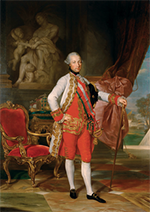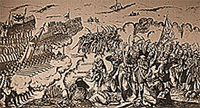The United Belgian States
The United Belgian States was a brief window into modern independence for a collection of Low Countries provinces in the late 18th Century. 
The Low Countries, comprising what is now Belgium and Luxembourg and the Netherlands, were at that time under the hegemony of the Holy Roman Empire. The Empire had taken over the Burgundian Circle in 1714, after the War of the Spanish Succession, and termed it the Austrian Netherlands. Ruling the empire at that time was Empress Maria Theresa. Her husband, Joseph II (right), was elected Holy Roman Emperor in 1764. The co-rulers considered themselves Enlightened absolutists. After she died, in 1780, Joseph introduced reforms designed to give the people living within the confines of the Empire more freedoms. Adverse reaction to those reforms was widespread and varied. Eventually, enough people had had enough and talk of uprising began. The result was the Brabant Revolution, which featured a number of stunning victories of rebel armies over the vaunted imperial armed forces. Leaders of the revolution declared their independence, citing as precedents the 1581 Dutch Act of Abjuration, which created the Dutch Republic, and the 1776 Declaration of Independence, which informed the creation of the United States. Independences declared, the leaders formed a new entity, the United Belgian States, which launched on Jan. 11, 1790 and was run by a weak, centralized Sovereign Congress. The eight provinces (Brabant, Gelderland, Hainaut, Mechelen, Namur, Tournai, Tournaisis, and West Flanders) were sovereign and independent, nominally reporting to the head office in Brussels but essentially operating as their own entities overall. 
Not long after the launch of the union, factionalism took hold. One of the emperor's more outspoken critics was a lawyer, Henri Van der Noot (left), who claimed that the reforms violated longstanding political principles. Van der Noot and his followers, known as Statists, were more conservative, preferring to shake off the shackles of the empire but not to embrace the liberalism that was propelling the French Revolution. Leading the other faction was Jan Frans Vonck (right), also a lawyer, who had formed a secret revolutionary society and had contributed handily to the rebel army's eventual success; the Vonckists, as they were known, wanted more of a say in their government and generally had more liberal views than their Statist counterparts. The conflict turned violent, and the Statists gained the upper hand, forcing many Vonckists to abandon their recently gotten gains. The Statists, led by Prime Minister Van der Noot, turned to persecution and imprisonment to maintain supremacy. Austria, meanwhile, was too busy with other matters to intervene. Joseph II had contracted a lingering illness; at the same time, imperial troops were fighting in the east, against the Ottoman Empire. Left with a free hand, the Statists implored other European powers to recognize their nascent state; none did. 
Joseph II died in February 1790. His brother Leopold II succeeded him, made peace with the Ottoman Empire, and turned his fury on the United Belgian States. Imperial troops invaded and found a land in disarray. The Statists cobbled together an army and fought, at Falmagne, on September 28. The Empire was victorious, there and elsewhere. The Sovereign Congress, seeing the writing on the wall, dissolved itself on November 27. Six days later, Brussels surrendered, and the Empire was once again master of the Austrian Netherlands. |
|
Social Studies for Kids
copyright 2002–2025
David White




